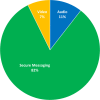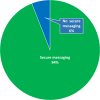Uptake and patient and provider communication modality preferences of virtual visits in primary care: a retrospective cohort study in Canada
- PMID: 32636284
- PMCID: PMC7342856
- DOI: 10.1136/bmjopen-2020-037064
Uptake and patient and provider communication modality preferences of virtual visits in primary care: a retrospective cohort study in Canada
Abstract
Objectives: To evaluate the uptake of a platform for virtual visits in primary care, examine patient and physician preferences for virtual communication methods and report on characteristics of visits and patients experience of care.
Design: A retrospective cohort study.
Setting: Primary care practices within five regions in Ontario, Canada after 18 months of access to virtual care services.
Participants: 326 primary care providers and 14 291 registered patients.
Interventions: Providers used a platform that allowed them to connect with their patients through synchronous (audio/video) and/or asynchronous (secure messaging) communication.
Main outcome measures: User-level data from the platforms including patient demographics, practice characteristics, communication modality used, visit characteristics and patients' satisfaction.
Results: Among the participants, 44% of registered patients and 60% of registered providers used the platform at least once. Among patient users, 51% completed at least one virtual visit. The majority of virtual visits (94%) involved secure messaging. The most common patient requests were for medication prescriptions (24%) and follow-up from previous appointment (22%). The most common provider request was to follow-up on test results (59%). Providers indicated that 81% of virtual visits required no follow-up for that issue and 99% of patients reported that they would use virtual care services again.
Conclusions: While there are a growing number of primary care video visit services, our study found that both patients and providers in rostered practices prefer secure messaging over video. Despite fears that virtual visits would be overused by patients, when patients connected with their own primary care provider, many virtual visits appeared to replace in-person visits, and patients did not overwhelm physicians with requests. This approach may improve access and continuity in primary care.
Keywords: information technology; primary care; telemedicine.
© Author(s) (or their employer(s)) 2020. Re-use permitted under CC BY-NC. No commercial re-use. See rights and permissions. Published by BMJ.
Conflict of interest statement
Competing interests: None declared.
Figures




References
-
- The BMJ General practice by smartphone. Available: https://www-bmj-com.myaccess.library.utoronto.ca/content/366/bmj.l4713 [Accessed 25 Jul 2019].
Publication types
MeSH terms
LinkOut - more resources
Full Text Sources
